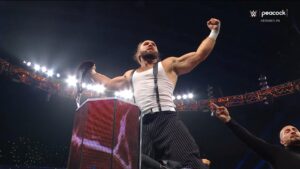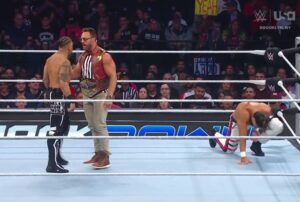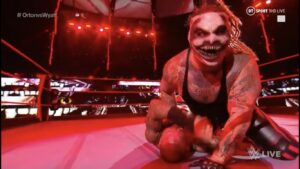In this series, James Staynings takes a deep dive into AEW’s short but impactful history, its present, and its future. In part 1, James discussed how AEW changed the wrestling industry (here). In Part 2, James discussed how AEW’s continued existence benefits wrestlers and fans alike (here).
This part 3 section is divided into two articles to fully explore why and how AEW creative has experienced growing pains and has polarised fans (Part 3A here). The final part will discuss AEW’s future. Including discussing the problems that AEW faces and questions Tony Khan will have to address.
More Than a Slogan
“Where the Best Wrestle,” Tony Khan, AEW’s tagline.
AEW has set a high standard for itself in its short five years of history. In its back catalogue, I would argue that AEW has in its collection some of the greatest storylines and matches of the 21st century. AEW lived up to the promise for so long of giving wrestling fans what they wanted.
The tagline, which the company has adopted helps not only distinguish itself from WWE, makes clear the company’s mission statement. It makes it clear to fans what to expect. AEW puts wrestling first.
As I’ve written about previously, AEW at its peak has been Nirvana. In more recent years, that sense of transcendence has primarily occurred in the wrestling itself. Rather than in the storyline build or consistently in character development. WWE, its supporters and most industry insiders prioritize storytelling over in-ring excellence. Especially for generating both an emotional and financial investment.
At the same time, to suggest that the wrestling itself is not part of the draw, part of the connection fans have with the product is to treat the in-ring aspects as somehow lesser. As some AEW fans rightly highlight, to complain or insult a wrestling show for having too much wrestling or making wrestling fun missing a huge part of what captures fans.
Perhaps in part, it’s a hang-up from Vince McMahon’s psychology that’s engrained in the wrestling business philosophy. Then again, until post-Brawl Out, AEW had a balance between storytelling and in-ring action.
Imbalance
Since there has been an imbalance between these two important factors. Its effect has been noticeable in both AEW’s business and critical reception, including some fans’ enjoyment of the product.
More often it feels like Khan’s increasing reliance on giving the fans excellent wrestling and giving fans more of the fantasy of what we’ve always wanted has created a disparity. It’s caused parts of AEW to break some of its promises and the core narrative framework will not fix wider issues. In places, it’s led to diminishing returns.
Overcompensating with genre-pushing and boundary redefining wrestling, contrasted against issues in storytelling have not recaptured the feeling the AEW of 2024 is striving for. The balance is wrong and for some AEW fans like myself, it’s only highlighted systematic issues.
Business or Pleasure?
Criticism of Tony Khan’s approach from wrestling insiders and podcasters has trickled down into the general online conversation on social media. Khan as a fan, books matches that appeal to some wrestling fans.
Some other fans have an issue with this approach. I’m not one of them. Other fans are more inclined to talk about wrestling from the standpoint of business rather than focus on their subjective enjoyment. Can we acknowledge the strangeness of this?
As both a sports fan and theatre lover, I rarely factor economics into my enjoyment of these pursuits. I’d be lying if I said at times, it wasn’t a concern given the number of UK rugby teams that have gone bust or the declining attendance of theatres. This is a concern. Just not when as a fan, I am focusing on being immersed and entertained.
Perhaps it’s a consequence of so many insider podcasts and shoot interviews over the years discussing the business side of wrestling. Even CM Punk himself in his MMA Hour Interview talked about what the wrestling business should be and how he thought AEW had its priorities wrong.
For some fans, talking about metrics has been an easy way to target, insult and assert AEW’s inferiority. Attendance, ratings, etc, to justify saying the promotion is in a bad place. It parrots much of what the anti-AEW cottage industry peddles.
The reality is some fans have stopped watching AEW because they don’t enjoy the product anymore. This is my metric of focus in this series rather than the sacred cow that is “this business”.
We’re Spoilt
When earlier this month Tony Khan joked using a Tommy Boy reference that he books for the “sickos”, social media was divided as usual.
On the one hand, some AEW fans read this as further proof that Tony Khan is a fan at heart. Those on the other hand used the phrase “mark” unironically. As alongside a swear word or two to insult the AEW owner and millionaire.
Unironic because given the meaning of the word is a “fan”, aren’t we all marks? Then again, folks always find justification for othering and stating why another human is not as human as they are. Regardless, it tells us a lot about Khan’s mentality. As Cultaholic’s Andrew Kelly wrote: “Let’s be honest though, being a wrestling sicko is part of the fun”.
For me, Khan’s statement highlights both Tony’s strengths and weaknesses as a booker: giving fans what we want.
AEW as a promotion brought back importance and value to various old and misused concepts as discussed in my first article. From tournaments to wins and losses mattering to long-term storyline development and a sports-orientated framework built around rankings. Even revamping old concepts into something new like the Forbidden Door with promotions working together to share talent.
And we have been spoilt with the things we have enjoyed to the detriment of the balance. Imbalance has impacted another part of AEW’s USP: coherent and logical storytelling that treats fans’ intellect with respect.
It’s created a twofold issue. First, too much of any good thing becomes less impactful over time. Second, high standards and achievement lead to the normalisation of the in-ring product.
Lessening Impact
AEW made tournaments significant again. Conversely, in 2023, reliance on this trope multiple times to varying success (which you can read about here).
The Lights Out match, after several initial classics with Kenny Omega vs. Jon Moxley and Britt Baker vs. Thunder Rosa was reduced in stature. Orange Cassidy vs. Adam Cole used the gimmick as a story device to allow Cassidy to beat Cole while not harming the latter in chasing the AEW World Championship. This made the match also a concession to protect Cassidy. Side-stepping the significance of wins and losses.
At other times, an overreliance on open challenges or contenders getting multiple title shots undermined unpredictability also, as well as the narrative framework of how AEW should work.
Repeating Tropes
Daniel Garcia talked about climbing the rankings to face Will Ospreay for the International Championship. Yet Kyle O’Reilly got a shot on Collision after repeatedly losing two other title opportunities. It weakens AEW’s framework of wins and losses matter. Also, the return of the rankings (read here about the ranking’s pros and cons).
There is potential for a storyline at play with O’Reilly. Kyle cannot stand alone without the help of his friends who now make up The Undisputed Kingdom. But sacrificing AEW’s framework and lore to suit storylines is a flexibility that had a bugbear of fans have previously associated with WWE.
Equally, if this is the story, it’s somewhat diluted. The trope has impacted my investment in O’Reilly as a character. As a fan, I appreciate him, but rather than the fiction, I’m more focused on the worker.
It is a smell I’ve associated with Kyle’s former tag partner, Bobby Fish. Also, current roster members like Jay Lethal, Brian Cage and Kyle Fletcher. All systematically take Ls to build up other wrestlers.
The results are mechanically good matches that were previously great. Like magic, wrestling requires a suspension of belief. So, when the strings are so noticeable, the result predictable, it reduces my investment in the wrestlers’ characters. These matches become functionary and part of this has numbed me to the high standard AEW sets.
Excessive High Stakes
When AEW used blood and deathmatch-style stipulations, even on weekly TV, this once felt huge. Chris Jericho took on Nick Gage in a death match and it worked on multiple storyline levels.
First, from a story perspective, Gage as a hired killer for MJF fits the M.D.K leader like barbwire-wrapped fists. There was a believability in why he would take the job and the stipulation stacked the odds against Jericho. Likewise, nothing like this had happened on Dynamite before.
Over time, however, too much blood has lessened its effect. When Nick Wayne busted Swerve Strickland open in revenge for the gruesome assault Swerve had committed against Wayne the previous year, the crimson mask for me would have hit home more if weeks before someone else had not bled. This oversight lessened the impact of what could have been a stronger story beat in the Swerve/Christian feud.
The same has happened with Deathmatch gimmicks. Take Orange Cassidy vs. Matt Taven in a Texas Death Match. As a graphic, some commented this seemed like something from a fantasy booking simulator. The match itself was fun with a fantastic performance by both men. Yet short and long term, what did it achieve?
Cassidy continued to defend the International Championship “hurt”. A gimmick Cassidy had been working on for months prior. Taven, despite a highly praised performance, returned to being a lackey outside of ROH.
The stipulation did not fit the story or impact it. It was a great match. Yet one that risks impacting the lore of AEW’s Texas Deathmatch stipulation, like the Lights Out match.
Normalising the Spectacular
AEW is somewhat a victim of its success. Too much wrestling or doing wrestling well is not the issue. Producing excellent wrestling with athletes who can push the boundaries of possibilities every week is not the solution to wider creative issues.
This has been visible as far back as last year. Kenny Omega vs. El Hijo del Vikingo was a perfect victim of this. A dream match encounter that is delivered on the match graphic. Both pushed boundaries and the imagination of what could be possible. By the end of the week, headlines were stolen by CM Punk controversy.
The match faded despite its quality and excellent. Why? Because of wider issues within AEW’s backstage environment bubbled to the surface.
In-ring matches have not previously compensated when cyclically a pro wrestling company runs cold. The New Generation Era featured phenomenal wrestling from the likes of Bret “The Hitman” Hart, Sean Waltman and Shawn Michaels. AEW has an entire roster of wrestlers inspired by these wrestlers. A roster who are already taking the artform further.
Realistically, has any other company in the slumps produced such a strong wrestling product?
The problem with boundary-pushing is eventually today’s excellence can become tomorrow’s standard. AEW’s wrestling can be Nirvana-like. PPVs especially hit such a peak. However, as hinted at in both articles on AEW’s present, there is stagnation and the normalisation of a new standard.
In divisions like the trios, the style has lost its spark. The thrill isn’t gone, but the pops and spectacle have been lessened. But things can be rebalanced.
Rebalancing or Change
Optimistically, there have been signs of gradual improvement. Some changes to the tropes I’ve discussed have been and are already happening. Elsewhere, The Owen’s return in a year where only one other tournament occurred (for the tag team titles) already made it feel more important.
The choice to book Will Ospreay against Swerve Strickland now rather than All In adds unpredictability that elsewhere this year has been lacking in the world championship picture. AEW hiring new creative staff, like Jennifer Pepperman for the women’s division and former TNA creative writer RD Evans, long-term could lead to further positive change.
It’s why AEW can be so frustrating for fans compared to WWE. AEW has shown what is possible, not just in the ring. For some that’s the grip is just wanting the promotion to be its best. The defensiveness around the high- quality of wrestling, as an almost sacred cow is understandable looking at the wider issues. Something I’ll discuss in a bonus article in this series soon.
What’s going to happen over time is AEW either finds its way back to the balance with the feeling of old, or if things begin to normalise, the promotion needs to find a way to change the perimeters to reset expectations. Either fill in those creative potholes or build a new road.
Looking for More Deep Dive Content?
If you’re also a WWE fan, James has done a series of articles examining the start of the Paul Levesque Era of WWE post-Wrestlemania XL and the impact of Vince McMahon leaving the promotion.
The first examines how The Paul Levesque Era has tried to move on from McMahonism while retaining key elements of Vince’s infrastructure (here). The second, James discusses how WWE has fulfilled fans’ long-desired wishes. Finally, AEW and how its relationship with WWE has changed since Vince McMahon left TKO Holdings (here).
More From LWOS Pro Wrestling
Header photo – AEW – Stay tuned to the Last Word on Pro Wrestling for more on this and other stories from around the world of wrestling, as they develop. You can always count on LWOPW to be on top of the major news in the wrestling world. As well as to provide you with analysis, previews, videos, interviews, and editorials on the wrestling world. You can catch AEW Dynamite on Wednesday nights at 8 PM ET on TBS. AEW Rampage airs on TNT at 10 PM EST every Friday night. AEW Collision airs Saturday at 8pm Eastern on TNT. More AEW content available on their YouTube.






